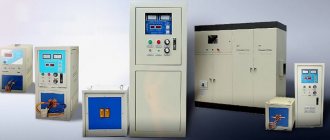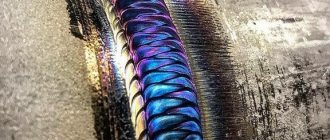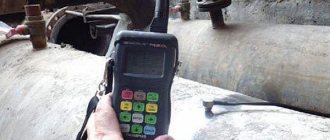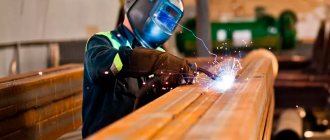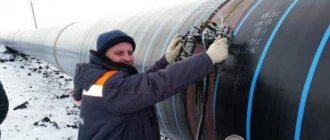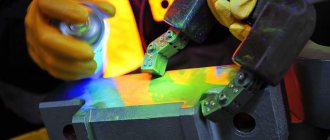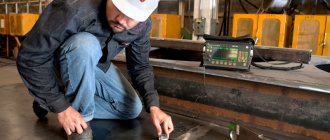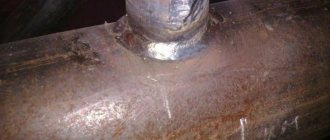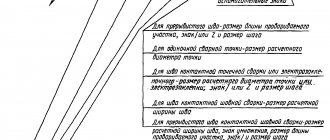During large-scale fabrication of metal structures and pipeline connections, additional processing is carried out, which novice welders forget about. One of these technological processes is the heat treatment of welds. It allows you to improve the characteristics of the finished fastener and extend its service life.
Heat treatment of welds
PURPOSE
The installation is designed to:
- Preliminary and concomitant (interlayer) heating of the edges of metal pipes before welding and during the welding process;
- Heat treatment of the weld zone;
- Heating the weld joint area before applying protective insulation.
The installation can be used for the repair of field and main pipelines, gas pipelines (condensate pipelines) and their branches made of pipe steels.
The installation is intended for operation in field conditions and in production workshop conditions.
The essence and purpose of the process
Post-weld heat treatment is needed to improve the deteriorating bonding characteristics of the material. These include:
- Changes in metal parameters due to overheating. When using welding equipment, parts heat up to 5000 degrees. Large grains of metal appear, which leads to a deterioration in ductility.
- A hardening area is formed around the finished seam. This area is not impact resistant.
- Removed areas have a low strength index. This is due to short-term strong heating.
The main disadvantage that forms on the connected structure after welding is internal stress. This leads to deformation of the product during operation. Residual stress causes the destruction of connections, causing pipelines and metal structures to become unusable.
Heat treatment is carried out at temperatures up to 1000 degrees Celsius. The technological process consists of three stages:
- Using special equipment, uniform heating occurs in the seam area. This changes the mechanical properties of the material.
- Maintaining operating temperature for a certain period of time. The duration depends on how much the properties and structure of the material need to be changed.
- The last step is cooling. The temperature must drop evenly to achieve an increase in ductility and toughness.
Heat treatment after welding allows you to remove residual stresses, level the metal structure, and get rid of large grains.
ADVANTAGES
- Heating occurs much faster than with gas-flame or resistive methods;
- Even at low ambient temperatures, heating occurs with high efficiency, compared to resistive and gas-flame methods;
- The heating rate is controlled within specified limits and is characterized by a high degree of stability;
- Heating occurs uniformly and is localized across the entire width of the welded joint zone and along the entire circumference of the pipe;
- Eliminates the risk of damage to the factory pipe insulation;
- There are no open flames or live elements;
- There is no need to store large quantities of gas reserves, and therefore cylinders, as with the gas-flame method.
Types of heat treatment
Heat treatment of welded joints can be carried out in several ways. The most effective include:
- Heating parts before welding. Used when working with low-carbon steels. The welder heats the working surfaces to 200 degrees. After welding, the structure should cool at room temperature.
- Release of metal. This involves heating parts to critical temperatures. The blanks are kept in this mode for up to 5 hours. The material is then slowly cooled.
- Thermal rest. The workpieces are heated to 300 degrees. They are kept at this temperature for up to three hours. Gradually, residual loads disappear, and the seam becomes stronger.
- Normalization. It is carried out to reduce large grains of the material structure and increase strength indicators.
- Austenization. Before welding, the parts are heated to 1100 degrees. The exposure at this temperature is 90 minutes. The cooling process takes place in the fresh air. Mechanical properties are improved and residual stress disappears.
- Stabilizing annealing. The finished seam is heated to 800 degrees. For three hours the temperature is maintained at the same level. Reduces the risk of rust formation.
The heat treatment method depends on the material used.
Application of heating elements
COMPOUND
- Frequency converter;
- Transformer-matching device;
- Set of inductors (depending on the purpose of the installation);
- Heating control panel;
- Pyrometric temperature sensor (measurement range 0 ÷ 400°C) – when heating is performed;
- Thermocouple temperature sensor (measurement range 0 ÷ 1200°C) – during heat treatment;
- Device for welding thermocouples (optional);
- Inductor water cooling station (optional);
- Specialized software for maintaining heating protocols;
- Set of connecting cables and sleeves.
Heat treatment technology
When carrying out heat treatment, the length of the seam is taken into account, uniform heating of the joint and adjacent areas is maintained, a suitable heating speed and temperature is selected, the heating duration time is set (also called dwell time) and the cooling rate is set.
Heat treatment of pipeline welds begins with the seam being insulated using heat-insulating material. For example, when using a gas-flame burner, the seam is wrapped with a layer of sheet asbestos 2-3 centimeters thick. Only then does the installation of the burner itself take place. The same principle applies when welding with induction devices or heating elements.
To ensure that welds do not lose heat, insulating materials must be strong and heat-resistant at the same time. At the same time, they should be light in weight and bend easily. The table below describes the main thermal insulation materials used in heat treatment. The temperature range is also indicated.
Processing of the weld seam is entrusted only to specialists. The specialist undergoes preliminary training and only after that begins work. In this case, the process should be led by a senior master. The specialist must not only select and install the heating equipment correctly, but also check how well the mechanics have prepared the metal. Heat treatment of pipeline welds will not begin without careful preparation.
After treatment, thermal rest can be carried out. Let the part cool down. Then the welds are ground with a grinder. Cleaning the weld after welding is necessary to remove unnecessary inclusions formed during welding. For example, slag.
SPECIFICATIONS
| Model | TIS 45/AC-PH | TIS 60/AC-PH | TIS 80/AC-PH | TIS 160/AC-PH | TIS 250/AC-PH | |
| Power supply parameters | 380/220V, 50Hz | |||||
| Maximum power | 45 kW | 60 kW | 80 kW | 160 kW | 250 kW | |
| Heat treatment parameters | ||||||
| Maximum pipe diameter | 630 mmWith a wall thickness of 14 mm | 1020 mmWith a wall thickness of 22 mm | 1220 mmWith a wall thickness of 22 mm | 1420 mmWith a wall thickness of 40 mm | 1420 mmWith a wall thickness of 70 mm | |
| Maximum wall thickness | 40 mm with diameter 325 mm | 50 mm with diameter 630 mm | 50 mm with diameter 820 mm | 60 mm with diameter 1020 mm | 70 mm with diameter 1420 mm | |
| Maximum heating temperature | 620-830 °C | |||||
| Heating speed (adjustable) | 1-50 ºС/min | |||||
| Maximum duration of the heat treatment process | up to 24 hours | |||||
| Parameters of preliminary and accompanying (interlayer) heating | ||||||
| Maximum pipe diameter | up to 1420 mm | |||||
| Maximum wall thickness | 70 mm | |||||
| Maximum heating temperature | 300 °C | |||||
Basic set UINT-100-2.4
| № | Name | Quantity |
| 1 | Universal induction heating installation with power - 100 kW, frequency - 2.4 kHz. | 1 PC. |
| 2 | Input cable (connected to unit) | 12 m. |
| 3 | Output cable (connected to unit) | 20 m. |
| 4 | Wire for inductor | 24 m. |
| 5 | Compensating capacitor (mounted on the trolley) | 4 things. |
| 6 | Two-channel recorder for measuring and recording the temperature of the heated part of the pipeline (built into the installation) | 1 PC. |
| 7 | Temperature rise and fall speed regulator (built into the unit) | 1 PC. |
| 8 | Thermocouple | 2 pcs. |
| 9 | Compensation wire (connected to the installation) | 40 m. |
| 10 | Manual | 1 PC. |
Basic set UINT-50-2.4
| № | Name | Quantity |
| 1 | Universal induction heating installation with power - 50 kW, frequency - 2.4 kHz. | 1 PC. |
| 2 | Input cable (connected to unit) | 12 m. |
| 3 | Output cable (connected to unit) | 20 m. |
| 4 | Wire for inductor | 22 m. |
| 5 | Compensating capacitor (mounted on the trolley) | 1 PC. |
| 6 | Recording single-channel device for measuring and recording the temperature of the heated part of the pipeline (built into the installation) | 1 PC. |
| 7 | Temperature rise and fall speed regulator (built into the unit) | 1 PC. |
| 8 | Thermocouple | 1 PC. |
| 9 | Compensation wire (connected to the installation) | 20 m. |
| 10 | Manual | 1 PC. |
The questionnaire can be downloaded here
Processing methods
There are three methods by which welded joints are protected:
- Heat treatment. Thanks to this method, it is possible to remove residual stresses in the material resulting from welding work. Heat treatment is carried out using one of two technologies: local, when only the connection itself is heated or cooled, or general - the entire part is subject to temperature treatment.
- Mechanical restoration. In this case, the task is to remove slag residues and check the reliability of the connection. A typical example of machining is tapping a seam with a hammer or sanding it. If the slag is not removed, corrosion may develop.
- Chemical treatment. Applying protective coatings to joints is one of the ways to combat corrosion processes. The most affordable option for chemical protection is treating the seam with a primer paint and varnish material.
Below we will look at weld protection technologies in more detail.
Chemical treatment
The best results when processing welded joints are achieved with a combination of mechanical and chemical means. Two methods of working with seams are used: etching and passivation.
Etching is performed before mechanical grinding. To carry out this operation, chemical compounds are used to provide a uniform coating that prevents corrosion processes. In addition, etching allows you to eliminate areas affected by tarnish. The fact is that in such places there is an accumulation of nickel and chromium oxides, as a result of which the steel becomes rusty.
In small areas of welded joints, it is recommended to carry out etching by directly applying the composition to the surface to be treated. If the part is large enough or has a complex configuration, it should be placed in a container with an etching solution. The time the metal remains in the etching flow is calculated individually in each situation.
When etching is completed, passivation begins. The process involves applying a special composition to the metal, resulting in the formation of a film. This protective coating prevents corrosion. From a chemical point of view, passivation can be explained as follows: oxidants, interacting with steel, remove free metal from the surface, thereby activating the formation of a protective film.
The chemical treatment is completed by cleaning the welded joints from reagents. The flushed water contains many toxic substances, heavy metals and acids. Acids are neutralized with alkalis, and then the remaining liquid is filtered. Waste material must be disposed of only in specially designated areas in accordance with environmental protection legislation.
Heat treatment
Heat treatment of welded joints is often used in the process of constructing pipelines. To create them, pipes are used that have a large internal diameter and significant wall thickness. This will ensure the strength and reliability of the system during operation. But this creates a new problem - it is difficult to carry out high-quality joining of pipes that have such geometric characteristics.
During the welding process, a small area of the product is heated. As a result, this leads to the emergence of a number of physical processes that adversely affect the operation of the structure.
The heat treatment of welded joints itself is carried out in several stages:
- Preparation of products for welding. The strength of the connection depends on how well this work is done.
- Heat treatment of the joint of products during welding.
- Treatment of seams after welding.
Heat treatment is needed in order to improve the welding properties of metal structures. But, above all, products and seams can be annealed and highly tempered.
Why is it needed?
Welding is carried out under the influence of an electric arc, as well as filler material from the electrode. In this case, the temperature is 1500-50000C. As a result of such heating, various negative phenomena arise on thick metal, which are worth considering more carefully:
- Great overheating occurs at the junction of the weld and filler material. As a result, the crystallization of the metal, which has a large structure, increases. This significantly reduces its ductility. Also, during the heating process, manganese and silicon burn out. A section of a metal product becomes rigid and loses its original technical characteristics.
- There is a hardening zone near the seam, which also experiences heating. Of course, it is affected by a lower temperature than in the environment of direct connection of the filler and base material. As a result, certain elements are pierced in the metal. The area loses its original plasticity and becomes harder. The impact strength properties of the material also change.
- The softening zone is located at a remote distance from the place of direct welding of metal products. It is susceptible to the moderate temperature emitted by the electron arc. Due to the short duration of this process, the material retains its plasticity. But, as for strength, it decreases somewhat.
As a result of metal welding, residual stress is applied to the metal, which can lead to deformation. This may cause some difficulties when installing volumetric structures. This is especially true for places where new units will be installed.
The danger with residual stress is that it can cause cracks to form in the future. This is especially true for the welding area. This is unacceptable, since in the future it will lead to the destruction of the connection.
The situation worsens when, during the operation of the structure, high temperatures are applied to the welding site. This leads to a decrease in the metal’s resistance to corrosion processes and cyclic strength. This also applies to the ability of the metal to resist brittleness that occurs under the influence of low temperatures.
Features of the event
Heat treatment of welded joints is carried out at high temperatures, the value of which ranges from 700 to 10000C. Thanks to this, it is possible to eliminate the consequences of uneven heating that was carried out during arc welding. This is especially true for metal products that have significant thickness. As a result of processing, the seam is given a structure similar to the rest of the material.
Heat treatment of welded joints is carried out in three stages:
- The area near the connection is heated. For this, special equipment is used, which we will talk about later.
- An area or the entire product is kept at a certain temperature for a certain time.
- At the final stage, the material is systematically cooled to normal temperature.
Thanks to this process, it is possible to eliminate residual effects after arc welding, align the structure of the metal, and also relieve stress, which is often the cause of its deformation. The process is carried out in various ways. The technology for carrying it out depends on the thickness and type of material. Processing is not always carried out, but there are cases when it is simply necessary.
In the video: how the heat treatment process occurs.
Advantages and disadvantages
Processing the joint using the thermal method has certain advantages and disadvantages. Among the advantages are:
- As a result of the process, welded joints acquire new properties. As a result, the parts will become more suitable for use in certain conditions. This is especially true for protecting metal from corrosion.
- Processing allows you to eliminate some of the negative aspects that arose as a result of welding work.
- Heat treatment relieves residual stress that occurs during the welding process.
Of course, to achieve such a result, it is necessary to approach the processing correctly. This especially applies to compliance with certain rules. As for the disadvantages of this processing method, among them are:
- The process must be performed by an experienced specialist. This is because heat treatment is irreversible. This means that it is almost impossible to eliminate the mistakes made.
- To carry out the processing, you may need special equipment, which requires certain skills to operate. Especially when protecting pipeline welds.
- The procedure must be carried out exactly according to the requirements.
- In each case, its own processing parameters are selected.
If you follow certain rules, then no problems will arise during the process of stripping the joint.
What is being processed?
Heat treatment is often used in the construction of pipelines for various purposes. This primarily applies to pipes that have a diameter of more than 10 cm and a wall thickness of 1 cm or more. The process is carried out using induction heating with a current whose frequency is 50 Hz.
Heat treatment of pipes is quite simple. For this purpose, muffle furnaces and special electric heating wires, which have sufficient flexibility, are used. If the product has a thickness of no more than 2.5 cm, then gas-flame heating is used for processing. The main thing here is to evenly distribute the temperature in the area of the connecting seam.
Heat treatment is carried out not only on circumferential seams, but also on joints that have a different shape.
When processing welds, it is worth taking into account the thickness and characteristics of the metal. So, for example, if the pipeline is made of steel pipes whose wall thickness is 45 mm, then the process must be carried out immediately after welding. In this case, the cooling of the material should not reach 3000C. This also applies to products with a thickness of 25 mm.
If it is not possible to carry out processing, then the seam is protected with heat-insulating material. Clean up at the first opportunity. The process must be carried out within 3 days from the date of welding.
Process parameters
Features of heat treatment directly depend on the type and thickness of steel. Thus, in the case of chromium-molybdenum steel and its alloys, the process is carried out using induction or radiation methods.
So, depending on the thickness of the material and the method used, the processing process will take the following time:
| Metal thickness, mm | Radiation method, min | Induction method, min |
| 20 | 40 | 25 |
| 20-25 | 70 | 40 |
| 25-30 | 100 | 40 |
| 30-35 | 120 | 60 |
| 35-45 | 140 | 70 |
| 45-60 | 150 | 90 |
| 60-80 | 160 | 110 |
If you analyze the table, you can note that metal processing using the induction method takes less time. This is explained by the peculiarities of the process.
What equipment is used?
Heat treatment of welds is carried out using various means. When choosing, the thickness of the metal and the possibility of using this or that equipment in a certain place are taken into account. Today there are three main methods of heating the heat-affected area. Let's look at each of them.
Induction
A special device is installed on site, which generates high-frequency alternating voltage. A heating element is connected to it, which uses a flexible wire. It is wound onto a welding joint, which is previously wrapped in thermal insulating asbestos. This technology is used to process horizontal and vertical seams.
The wire is wound close to the insulator. In this case, a gap of 2.5 cm thick is left between the turns. As a result, 25 cm of the product is covered on both sides of the seam. When the coils are installed in accordance with all requirements and standards, the device turns on. This takes into account the operating time of the equipment. This directly depends on the thickness of the metal. During operation of the device, voltage passes through the turns, which creates induction, as well as heating the metal.
To perform processing, special belts that contain a certain number of wires are also widely used. This allows you to effortlessly and quickly prepare the product for cleaning after welding.
On video: induction heating of a pipe.
Radiation
The radiation method of processing welds is no less popular. Special nichrome wires are used as a heating element. Voltage is passed through them, which causes them to heat up. It is worth noting here that induction does not take part in the process. The material is heated using a hot wire. The heating elements are laid on a base made of heat-insulating material.
Gas-flame
This method is the cheapest. For heat treatment of welded areas, an acetylene mixture and oxygen are used. The method is used to process materials whose thickness is no more than 10 cm. A mouthpiece with large holes is installed on a burner filled with a combustible mixture. To ensure uniform heat supply to the surface being treated, an asbestos funnel is placed on the nozzle. This allows the flame to be distributed over a width of 25 cm.
When using this method, it is worth considering some features. So, in order to perform high-quality heat treatment of heat-affected areas, it is necessary to heat them simultaneously. This means that two burners take part in the process at once.
Types of heat treatment
Thermal treatment of a welded joint can be performed in several ways. The purpose of the process is taken into account. Among the main methods are:
- Thermal rest. In this case, the material is heated to 3000C. This temperature is maintained for two hours. As a result of the process, hydrogen in the weld is reduced and residual stress is relieved. This method is often used for materials that have thick walls, and also where it is not possible to use other technologies.
- High holiday. With this technology, the product can be heated at temperatures up to 7000C. This treatment lasts about three hours. The duration of heat action on a material directly depends on its thickness. This method allows you to remove residual stress by almost 90%. When it comes to processing low-alloy steel, the result is destruction of the hardening structure and the carbides become larger. In this way, an increase in ductility and toughness can be achieved. This technology is often applied to pearlitic steels.
- Normalization. This method involves simultaneous heating of the material and the weld to a temperature of 8000C. In this case, heat treatment should not exceed 40 minutes. Using normalization, residual stress can be partially relieved. But the main advantage is that the processing results in a homogeneous and fine-grained structure. This in turn improves the mechanical properties of the seam and heat-affected areas. Normalization is often used on materials that are thin.
- Austenization. The material is heated to a temperature of 11000C. The thermal effect continues for two hours. After this, the material is cooled in air. It is not recommended to perform forced cooling, as this will lead to a decrease in the strength of the metal and, as a result, to the appearance of cracks. Austenization is used on high-alloy steels. With its help, the plasticity of the material increases and the residual stress decreases.
- Stabilizing annealing. The method is used for processing materials with a superimposed seam. It is heated at a temperature of 9700C for three hours. After this time, the material is allowed to naturally cool in air. Stabilizing annealing can prevent the occurrence of intercrystalline corrosion. The technology is often used on high-alloy steels. This will protect the areas from corrosion.
Heat treatment is used on products made of various metals. With its help, their service life is increased. To carry out the process correctly, it is necessary to carefully select the operating temperature, heating method, and time of heat treatment. Cleaned products must be handled very carefully so as not to damage them.
Which method should I choose?
The choice of technology for heat treatment of welded joints directly depends on the physical and chemical characteristics of the material. This is evidenced by the grade of steel. Experts recommend paying particular attention to meeting technological requirements. Otherwise, the quality of the weld is significantly reduced, which in the future can lead to its complete destruction.
When performing heat treatment of a welded joint, it is worth considering the following parameters:
- the width of the area that will be processed;
- uniform thermal effect on the material, both in thickness and width;
- heating duration;
- Features of cooling the material after heat treatment.
If you take into account all these features, you can choose a heat treatment method that will improve the quality of the connection. This is especially true for its strength.
Temperature control
As already mentioned, during the heat treatment process it is necessary to carefully monitor the heating temperature. To achieve this goal, special tools are used, such as thermal pencil and thermal paint. When they reach a certain temperature, they suddenly change color. Depending on the principle of operation, such thermostats can be chemical or melting.
When a certain temperature is reached, chemical temperature regulators change color as a result of a reaction between the components. The measurement accuracy is directly affected by the time of thermal exposure of the material, as well as pressure fluctuations.
If heating is carried out for 3 minutes, then the measurement error will be no more than 100C. It is worth noting that a change in the shade of heat controllers occurs at critical temperatures.
In pencils and paints of the second type, the change in shade occurs as a result of the melting of a substance that is very sensitive to increased temperature. Unlike chemical temperature indicators, these agents change regardless of the duration of heat exposure. This allows you to more accurately set the heating temperature. In this case, the error is no more than 20C.
Thermal melting indicators have many advantages, among which it is worth highlighting their inertness to variable temperature, vacuum, solar radiation, sea fog and other negative environmental factors that can affect the accuracy of measurements.
Thermal pencils and thermal melting paints are divided into two types:
- Adsorbent. The indicator consists of a pigment in a binder solution and a suspension of a substance that is sensitive to temperature increases during heating of the material. As a result of thermal exposure, the heat-sensitive substance melts, after which it is adsorbed by the color pigment.
- Melting varnishes. They have a certain melting point. The substance is applied directly to the surface to be treated. It dries quickly, after which a rough surface is formed. As a result of reaching a certain temperature, it will become glossy.
Today, paint and varnish factories are engaged in the production of thermal indicators. At the same time, they provide information about the critical melting points of a particular substance. This allows you to significantly improve the quality of heat treatment of welds.
